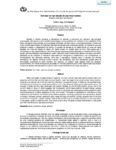Use este identificador para citar ou linkar para este item:
http://www.alice.cnptia.embrapa.br/alice/handle/doc/965994Registro completo de metadados
| Campo DC | Valor | Idioma |
|---|---|---|
| dc.contributor.author | ELOY, A. M. X. | pt_BR |
| dc.contributor.author | PEREIRA, E. P. | pt_BR |
| dc.date.accessioned | 2013-09-10T11:11:11Z | pt_BR |
| dc.date.available | 2013-09-10T11:11:11Z | pt_BR |
| dc.date.created | 2013-09-10 | pt_BR |
| dc.date.issued | 2013 | pt_BR |
| dc.identifier.citation | Revista Brasileira de Reprodução Animal, Belo Horizonte, v. 37, n. 2, p. 156-163, abr./jun., 2013. | pt_BR |
| dc.identifier.uri | http://www.alice.cnptia.embrapa.br/alice/handle/doc/965994 | pt_BR |
| dc.description | Resumo: Quando o homem começou a domesticar os animais e colocá-los em cativeiro, sua principal preocupação restringia-se a como impedi-los de escapar e como poderiam ser mantidos vivos e saudáveis. Mais tarde, começaram a se preocupar com a produção, sobretudo de leite e carne, o que exigia aumentar o número de crias. Durante esses tempos, os distúrbios advindos do estresse eram problemas, apenas, na medida em que eles afetavam a saúde e o desempenho do animal. O conceito de estresse só foi desenvolvido ao longo de várias décadas, por volta da metade do século 20, dando origem ao modelo atual em foco. Este sugere que a homeostase, ou seja, estabilidade por meio de mudanças, as quais acarretam alterações no metabolismo do corpo, ajuda o animal a antecipar novos desafios e, assim, responder a eles, contribuindo, dessa forma, para uma melhor adaptação ao seu ambiente. O estresse é responsável por alterações no metabolismo e, em consequência, no funcionamento dos diferentes sistemas, entre eles o reprodutivo. Estudos sobre o estresse nos animais domésticos, em especial bovinos, ovinos e suínos, são abundantes, pois eles representam grande parte da alimentação consumida no globo terrestre. Em caprinos, no entanto, esses estudos ainda são escassos, provavelmente, em virtude de sua pouca expressão no mercado global de carne e leite. Esta revisão visa mostrar os tipos de estresse mais estudados no caprino macho e sua interferência na função reprodutiva. [Stress on male goat reproduction]. Abstract: When man began to keep animals in captivity, his main concern was restricted to prevent them from escaping, and how they could be kept alive and healthy. Later they began to be concern about the production, focusing on producing more milk and meat and, therefore, increase the number of offspring. During these times, the disturbances arising from stress were problems only if they affect the health and animals performance. The concept of stress has only been developed over several decades, by the mid-20th century, giving rise to the current model in focus, in which suggests that homeostasis, which means stability through change, causing changes in the functioning of the body, help the animal to anticipate new challenges and thus respond to them, thus contributing to a better adaptation to their environment. The stress is responsible for alterations in body metabolism and, therefore, the function of the different systems, including among them the reproduction. Studies on stress in domestic animals, especially cattle, sheep and pigs are plentiful, as they represent most of the food consumed on the globe. In goats, however, these studies are still scarce, probably because of its low expression in the global market of meat and milk. This review aims to show the types of stress most studied in male goats and their interference on reproductive function. | pt_BR |
| dc.language.iso | por | pt_BR |
| dc.rights | openAccess | pt_BR |
| dc.subject | Estresse | pt_BR |
| dc.subject | Welfare | pt_BR |
| dc.title | Estresse na reprodução de caprinos machos. | pt_BR |
| dc.type | Artigo de periódico | pt_BR |
| dc.date.updated | 2015-04-15T11:11:11Z | pt_BR |
| dc.subject.thesagro | Caprino | pt_BR |
| dc.subject.thesagro | Stress | pt_BR |
| dc.subject.thesagro | Bem-estar | pt_BR |
| dc.subject.nalthesaurus | Goats | pt_BR |
| riaa.ainfo.id | 965994 | pt_BR |
| riaa.ainfo.lastupdate | 2015-04-15 | pt_BR |
| dc.contributor.institution | ANGELA MARIA XAVIER ELOY, CNPC; E. P. Pereira, Universidade Estadual Vale do Acaraú (UVA) - Sobral, CE, Brasil. | pt_BR |
| Aparece nas coleções: | Artigo em periódico indexado (CNPC)  | |
Arquivos associados a este item:
| Arquivo | Descrição | Tamanho | Formato | |
|---|---|---|---|---|
| APIEstressenareproducao.pdf | 380,16 kB | Adobe PDF |  Visualizar/Abrir |









